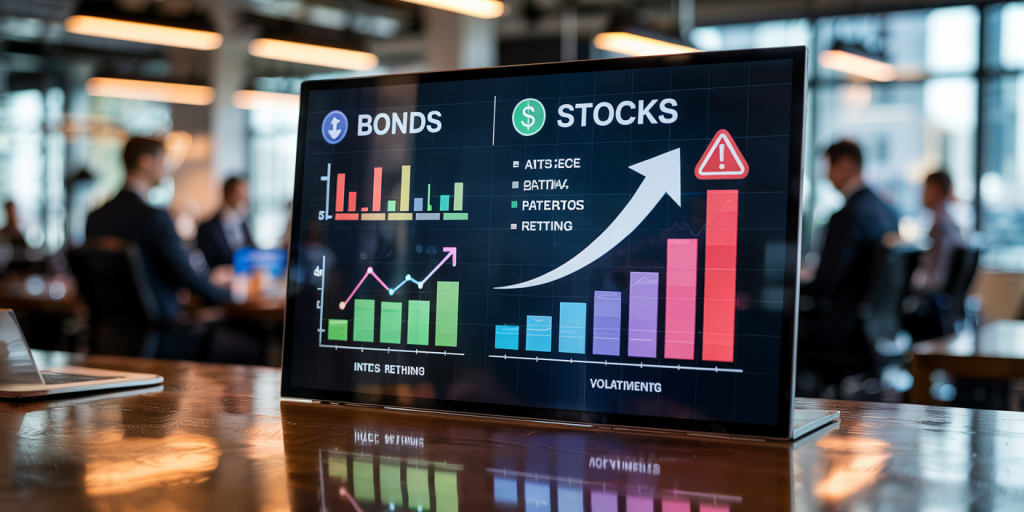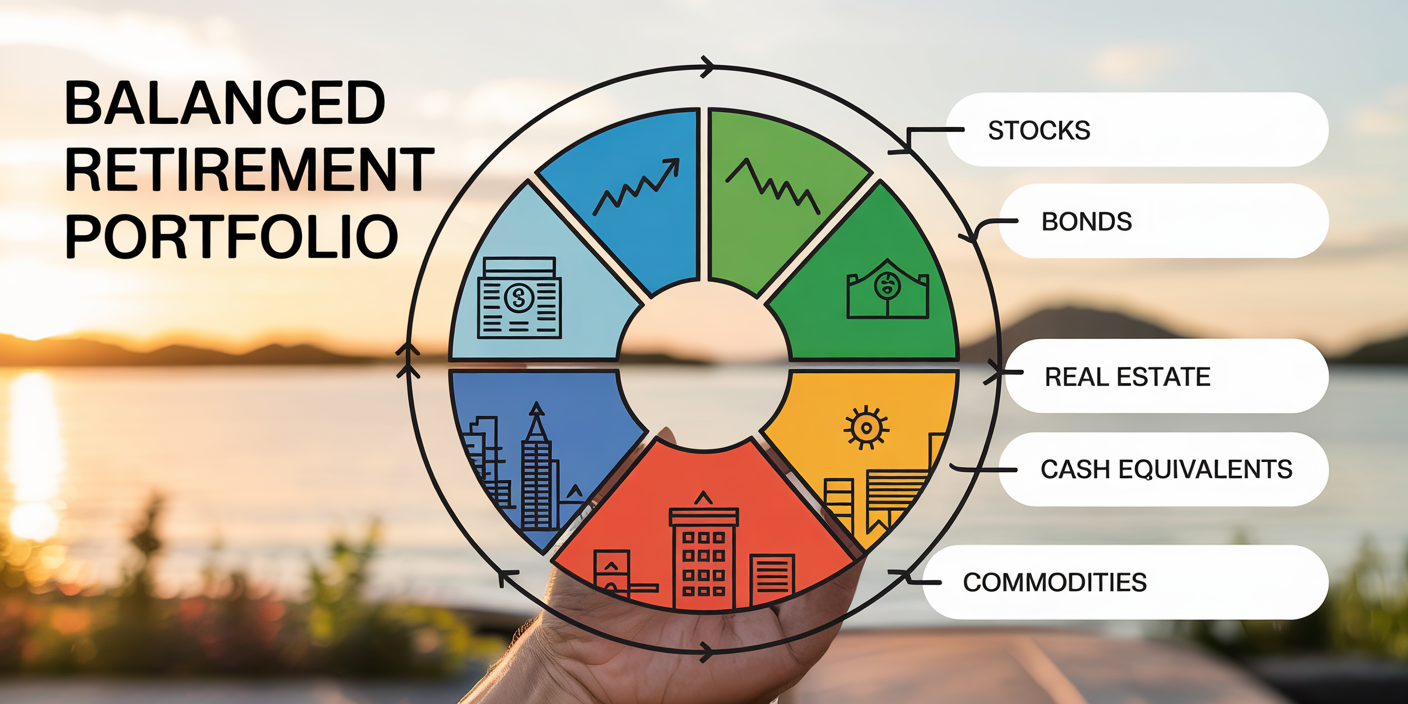Detailed Analysis: Bonds vs. Stocks in Today’s Economy
Anúncios
In the ever-evolving world of finance, investors constantly grapple with the decision of whether to allocate their assets to bonds or stocks. The dynamic nature of today’s global economy, influenced by factors such as inflation rates, geopolitical tensions, and monetary policies, makes this decision particularly challenging. Both asset classes offer unique benefits and risks, and understanding their performance in the current economic climate is critical for making informed investment choices.

In recent years, the economic landscape has experienced significant volatility. From the extraordinary fiscal stimulus measures during the COVID-19 pandemic to the subsequent inflationary pressures and central banks’ interest rate hikes in 2023 and 2024, investors face a complex environment when choosing bonds or stocks. This article provides a detailed analysis of bonds versus stocks by dissecting their performance drivers, risk-return profiles, and their roles within diversified portfolios in today’s economy.
Anúncios

Understanding Bonds: Stability Amid Uncertainty
Anúncios
Bonds are debt securities issued by governments, municipalities, or corporations to raise capital. Bondholders receive periodic interest payments (coupon payments) and are repaid the principal amount at maturity. Traditionally, bonds are viewed as lower-risk investments compared to stocks, offering a more predictable income stream.
In 2023, the bond market underwent substantial adjustments due to sharp interest rate increases by major central banks such as the Federal Reserve and the European Central Bank. For instance, the U.S. 10-year Treasury yield climbed from around 1.5% at the start of 2022 to over 4% by mid-2023. This rise raised bond yields, providing higher income opportunities to new investors but also causing losses for those holding bonds issued at lower interest rates because bond prices move inversely to yields.
The appeal of bonds in turbulent economic times lies in capital preservation and steady income generation. For instance, during the 2022–2023 period of elevated inflation (reaching over 8% at its peak in the U.S.), high-quality government bonds, although volatile, still acted as a safer harbor compared to stocks for risk-averse investors. Corporate bonds, especially investment-grade ones, provided enhanced yields, although their risk profiles varied based on issuer creditworthiness.

Stocks in Today’s Economy: Growth Versus Volatility
Stocks represent partial ownership of companies and grant investors the potential for capital appreciation alongside dividends. They are inherently more volatile than bonds but historically provide higher long-term returns. Stocks are influenced by company performance, economic growth prospects, and market sentiment.
In the current economic scenario, stock markets have experienced a rollercoaster ride. For example, the S&P 500 index faced a correction of around 20% in 2022 due to inflation fears, but rebounded significantly in early 2023 amid corporate earnings beats and optimism around AI technology advancements. However, geopolitical risks such as the Russia-Ukraine conflict and supply chain disruptions continue to inject uncertainty.
Technology and healthcare sectors have led gains, reflecting their growth potential even amidst inflation. Tesla, for example, surged over 60% in the first half of 2023 by capitalizing on electric vehicle demand, while healthcare companies like Moderna benefited from vaccine developments. On the downside, volatile commodity prices and the rising cost of capital have squeezed profit margins in industrial and consumer discretionary sectors.
Stocks remain an essential vehicle for investors seeking capital growth, but they require tolerance for short-term fluctuations. Dividends provide an additional layer of return; according to Nasdaq data, dividend-paying stocks in the S&P 500 yielded over 1.8% on average in 2023, a figure growing in importance as bond yields rise.
Comparative Analysis: Risk, Return, and Income Profiles
| Feature | Bonds | Stocks |
|---|---|---|
| Risk Level | Generally lower risk | Higher risk due to market volatility |
| Typical Return | 2% – 6% (varies with credit risk and interest rates) | Historically 7% – 10% annually over long term |
| Income Stability | Steady coupon payments | Dividends may fluctuate or be suspended |
| Capital Appreciation | Limited potential, mostly stable | High growth potential, but prone to downside |
| Inflation Protection | Usually low; real yields often negative in high inflation | Can offer some hedge if companies pass inflation costs to consumers |
| Default Risk | Varies by issuer; government bonds generally very low risk | Company bankruptcy risk exists, but diversified indexes mitigate |
The above table highlights the fundamental differences, aiding investors in balancing portfolio allocations. Bonds tend to shield against bear markets in stocks, providing diversification benefits. For example, during the 2022 downturn, the Bloomberg U.S. Aggregate Bond Index initially plummeted due to interest rate shocks but started to recover in late 2023 as real yields normalized. Meanwhile, stocks recovered at a quicker pace but with notable volatility.
Role of Bonds and Stocks in a Diversified Portfolio
Asset allocation is paramount in mitigating risk and achieving sustainable growth. A common rule of thumb, such as the “60/40” portfolio—60% stocks and 40% bonds—has been a long-standing approach, though it faces challenges in today’s environment.
With bond yields climbing but inflation remaining above target, fixed income offers improved income yet diminished real returns. Stock valuations, conversely, face pressure from higher discount rates, but growth sectors still provide opportunities. Combining both asset classes can reduce portfolio volatility while enhancing total returns.
Practical cases reveal diversified strategies’ merits. For example, during 2022’s market turbulence, investors heavily overweighted in stocks experienced sharper drawdowns. Conversely, those with bond allocations retained capital and could reinvest at higher yields currently. Fidelity Investments data indicates that well-balanced portfolios had an average volatility reduction of up to 20% compared to equity-only portfolios over the last two years.
Investors must also consider duration and credit quality in bonds. Short-duration bonds reduce interest rate risk, while investment-grade bonds limit default exposure. In stocks, diversification across sectors and geographies can mitigate specific risks, such as regional recessions or sector downturns.
Economic Indicators Affecting Bonds and Stocks
Several macroeconomic indicators influence the relative attractiveness of bonds versus stocks. Key factors include interest rates, inflation, GDP growth, and unemployment rates.
Central banks’ monetary policies play a crucial role. For example, the Federal Reserve’s decision to raise the federal funds rate from near zero in 2022 to around 5% in 2023 followed persistent inflation above 7%. Higher rates typically lead to lower bond prices but higher yields for new issues, altering the investment calculus. Stocks may suffer initially due to higher borrowing costs and discounted earnings valuations but can benefit if rate hikes successfully tame inflation and stabilize the economy.
Inflation remains a critical factor. In environments with runaway inflation, bonds often underperform in real terms unless they are inflation-indexed (such as TIPS in the U.S.). Conversely, stocks can pass costs onto consumers, maintaining earnings.
GDP growth drives corporate profits and investor sentiment. The International Monetary Fund (IMF) projected a global growth slowdown in 2023 to about 2.9%, down from 3.4% in 2022. Slower growth may dampen stock returns but could maintain demand for the steady income bonds provide.
Unemployment rates also matter as a labor market strength signals consumer spending potential, influencing stock earnings positively. However, tight labor markets may pressure wages, leading to inflation and thus complicate the bond market scenario.
Future Perspectives: Navigating Bonds and Stocks Ahead
Looking forward, investors must prepare for an evolving macroeconomic backdrop. The central question is whether inflation will sustainably decline toward central bank targets, enabling interest rate cuts or necessitating prolonged restrictive policies.
If inflation does settle below 3%, bond markets may stabilize, offering real positive yields and regaining their traditional role as portfolio diversifiers and income generators. Fixed income strategies incorporating inflation-protected securities could gain renewed appeal.
On the equity side, slower growth and higher rates may keep valuations modest, emphasizing quality and dividend-paying stocks over speculative growth. According to a 2024 Morningstar report, sectors like energy, utilities, and consumer staples are expected to outperform as defensive plays in uncertain times.
Technology advancements, such as artificial intelligence, cloud computing, and green energy, remain growth engines, but investors must price in higher costs of capital and regulatory risks. Global diversification gains importance as emerging markets present contrasting growth dynamics and inflation profiles.
Moreover, ESG (Environmental, Social, and Governance) investing shapes future market trends, influencing corporate behaviors and investor preferences. Both bond and stock markets are witnessing increased issuance and allocation toward sustainable instruments, reshaping traditional investment roles.
In summary, the evolving economic environment necessitates a nuanced understanding of bonds and stocks, emphasizing flexible strategies tailored to changing risk-return landscapes. Active portfolio management, continuous monitoring of economic indicators, and prudent diversification remain key pillars for success in today’s complex economy.



Post Comment